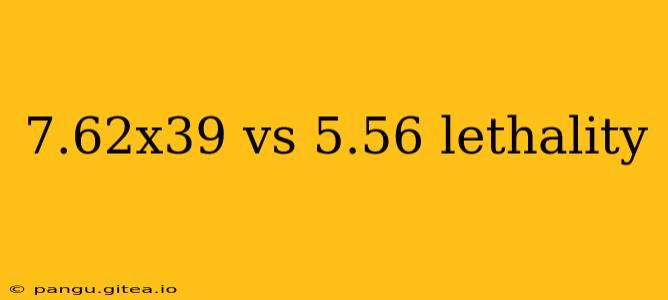The age-old debate: 7.62x39 vs 5.56 – which is more lethal? This isn't a simple question with a straightforward answer. The lethality of a cartridge depends on a complex interplay of factors beyond just caliber. Let's delve into the specifics to understand the nuances of this comparison.
Understanding Lethality: More Than Just Caliber
Lethality isn't solely determined by bullet size. Several crucial factors influence a round's effectiveness in incapacitating a target:
-
Bullet Construction: The design of the projectile significantly impacts its lethality. Full metal jacket (FMJ) rounds, commonly used in military applications, tend to pass through targets, causing less immediate damage than hollow-point rounds, which expand upon impact, creating a larger wound cavity.
-
Velocity: Higher velocity rounds deliver more kinetic energy, increasing their potential for damage. However, excessive velocity can sometimes lead to over-penetration, reducing the energy transferred to the target.
-
Energy Transfer: The amount of energy a bullet transfers to the target upon impact is critical. This energy is responsible for tissue damage and the creation of the wound cavity. Factors like bullet construction and velocity heavily influence energy transfer.
-
Wound Cavity: The size and shape of the wound cavity created by the bullet are crucial indicators of lethality. A larger, more irregular wound cavity generally results in more severe tissue damage and a higher likelihood of incapacitation.
-
Shot Placement: Regardless of the caliber, accurate shot placement is paramount. A well-placed shot, even with a smaller caliber round, can be far more lethal than a poorly placed shot with a larger caliber.
7.62x39: The Soviet Standard
The 7.62x39mm cartridge, developed in the Soviet Union, has a long history of use in military and civilian applications. Its characteristics include:
- Heavier Bullet: Generally carries a heavier bullet than 5.56 NATO rounds.
- Lower Velocity: Typically has lower muzzle velocity compared to 5.56.
- More Recoil: Produces higher recoil, making controlled bursts more challenging.
- Greater Stopping Power (Debated): While heavier and slower, the 7.62x39's larger diameter and greater energy transfer often lead to significant tissue damage, contributing to its perceived greater stopping power in close quarters. However, this is also heavily reliant on the specific bullet type.
5.56x45 NATO: The Western Standard
The 5.56x45mm NATO cartridge is widely used by militaries worldwide. Its characteristics include:
- Lighter Bullet: Utilizes a lighter bullet, resulting in less recoil.
- Higher Velocity: Features higher muzzle velocity compared to 7.62x39.
- Less Recoil: Easier to control during rapid firing.
- Superior Range & Accuracy (Generally): The higher velocity often translates to better accuracy and longer effective range. However, this can depend on barrel length and ammunition specifics.
- Potential for Overpenetration: Higher velocity can lead to over-penetration, reducing energy transfer to the target.
The Verdict: It's Complicated
There is no definitive "winner" in the 7.62x39 vs 5.56 lethality debate. The effectiveness of each round is heavily dependent on the factors mentioned above. While the 7.62x39 generally delivers more immediate stopping power due to its heavier bullet and energy transfer at close ranges, the 5.56 offers greater accuracy and range.
The choice between the two cartridges is often dictated by the specific application, including the expected engagement range, the type of ammunition used, and the desired level of control. Ultimately, accurate shot placement remains the most crucial factor determining lethality, regardless of the caliber chosen.
